
Participants in the Green Together project in the Wirral. Copyright Riverside and used with permission.
by James Carson
Good housing isn’t just about good houses. Residents of all ages need local spaces that are safe, and accessible, for leisure, to socialise, or to enjoy the health and wellbeing benefits provided by the natural environment.
Well-designed local spaces promote social cohesion, bring communities together and reduce anti-social behaviour. Housing associations already understand this: a 2011 good practice guide to green spaces from the National Housing Federation and Neighbourhoods Green (a partnership promoting open spaces for residents of social housing) reported that £41.5m was invested annually by housing associations in England to improve shared spaces in neighbourhoods. At the launch of the guide, Nicola Wheeler, Neighbourhoods Green project coordinator, highlighted some of the other benefits of green spaces:
“Local open spaces provide volunteering and employment opportunities, facilitate civic action and mitigate the effects of climate change.”
Neighbourhoods Green has also been working on a project with social housing associations and other partners in the Midlands. The Birmingham Active Neighbourhoods initiative is exploring how increased participation in housing green space can contribute to improved health outcomes for local people.
Another ambitious shared spaces project has brought together three of the UK’s largest housing groups: the Riverside Group; Places for People; and Peabody. Supported by a £15.6 million grant from the Big Lottery Fund, Green Spaces for People has transformed poor quality open spaces into well-designed areas for local people to enjoy. Projects include the introduction of parks and community gardens, as well as the creation of sports facilities, play areas, wildlife habitats, sensory gardens and green social enterprises. The aim of the five-year project has been not only to physically transform over 70 neighbourhoods around England, but to improve the quality of life for their residents.
One of the Green Spaces for People projects was “Steps to Sustainability”, delivered by the Riverside Group and its Merseyside partner Lairdside Communities Together between 2008 and 2013. The project has been generating a number of environmental improvements in the Tranmere/Rock Ferry area, which is home to 10,500 people. Once a thriving shipbuilding community, it suffered a body blow in 2001 with the closure of the Cammel Laird shipyard, from which employment in the area has yet to recover.
The Green Together project aimed to redevelop the area and to rekindle the community’s sense of pride in its surroundings through a number of different strands:
- Green Together Schools (eco gardens created at nine schools across the area as well as the launch of a junior neighbourhood warden initiative);
- Green Together Neighbourhoods (new green spaces, allotments brought back into use, and a range of youth engagement activities to improve the environment);
- Green Together Food (a food co-op run by the community as well as a healthy eating initiative);
- Green Together Services (focusing on the delivery of the overall project as well as exploring opportunities to create social enterprises where local people run their own environmental projects).
As with other successful regeneration projects, Green Together put local residents at the heart of the planning process. Volunteers living in the area helped to guide and monitor the project and to develop skills so that local people can continue to run the projects they have helped to create.
The Idox Information Service has a wealth of research reports, articles, case studies and evaluations on community engagement and regeneration. Items we’ve recently summarised for our database include:
Edible estates: a good practice guide to food growing for social landlords
Space to grow (sustainable regeneration), IN Holyrood, No 322 7 Jul 2014, pp63-64
Summerfield Eco Village, Birmingham: a leading sustainable community (Cities in Action case study)
Tree testament, IN Horticulture Week, 13 Jul 2012, pp22-23
Community gains (green space improvement), IN Horticulture Week, 18 Mar 2011, pp20-21
It’s Craigmillar time, IN Prospect, No 132 Autumn 2008, pp20-21,23
Urbanism (shared spaces), IN Prospect, No 128 Autumn 2007, pp59,61
N.B. Abstracts and full text access to subscription journal articles are only available to members of the Idox Information Service. For more information on the service, click here.
Share
Related Posts
Supporting residents on the decarbonisation journey: leveraging data for effective retrofit projects
As the drive towards decarbonisation intensifies, the social housing sector’s ability to collect, store and manage vast amounts of data becomes increasingly critical. With a shared goal of creating warmer, carbon-free homes, housing associations’ strategic use of data is essential ....
The recent spikes in energy costs have thrown into sharp focus the challenge of heating our homes. Domestic heating is important, not just for our comfort and wellbeing, but to reduce humidity and prevent condensation. But because traditional heating systems ....
Tackling geographical inequalities is critical for ensuring that all parts of the country have the potential to prosper. When the UK was a member of the European Union, it was entitled to a share of funding from the EU’s structural ....
By Ian Babelon A new-old concept for proximity “Are we there yet?” Parents may patiently nod to their children’s insistent nudges on a 20-minute journey to… somewhere. Quite rightly, researchers have asked: twenty minutes to what? The answer may well ....
